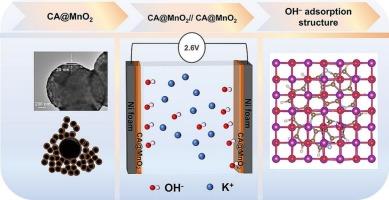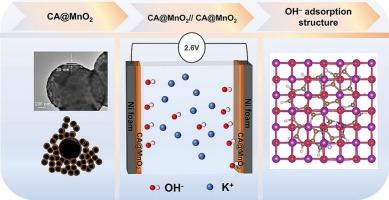CA@MnO2核壳异质结构在超级电容器中的应用
IF 13.2
1区 工程技术
Q1 ENGINEERING, CHEMICAL
引用次数: 0
摘要
构建核壳结构是提高超级电容器电极材料性能的有效途径。现有的核壳结构经常面临界面键合弱、高温下结构不稳定、电导率和活性位点难以平衡等常见问题。本文采用低温液相法制备了碳气凝胶(CA)异质结构包覆的氧化锰(MnO2)。Mn2+离子在弱碱性条件下进行氧化还原反应,在碳气凝胶骨架表面可控生长,合成均匀的氧化锰壳层。CA@MnO2不仅具有三维多孔结构,而且孔径范围丰富,比表面积高。同时,MnO2涂层的存在可以增强CA在高温煅烧过程中的结构稳定性。核壳气凝胶应用于超级电容器,具有较高的比电容(895.0 F/g)和优良的循环性能。应用于对称双电极超级电容器时,具有宽工作电压范围(2.6 V)和高能量密度(144.2 Wh/kg),功率密度为250.0 W/kg,具有优异的电学性能。计算结果表明,MnO2壳层与CA核具有明显的异质界面和强相互作用,可以改善导电性能,提高OH吸附能。核壳异质结构CA@MnO2是一种很有前途的超级电容器电极。本文章由计算机程序翻译,如有差异,请以英文原文为准。


Construction of CA@MnO2 core-shell heterostructure for supercapacitor applications
Constructing a core–shell structure is an effective way to improve the performance of electrode materials for supercapacitors. The existing core–shell structures frequently confront common issues such as weak interfacial bonding, structural instability at high temperatures, and the difficulty of balancing conductivity and active sites. In this article, we employ a low-temperature liquid-phase method to synthesize manganese oxide (MnO2) coated on carbon aerogel (CA) heterostructure. Mn2+ ions go through the redox reaction under weak alkaline conditions, controllable grow on the surface of carbon aerogels’ skeleton, and synthesis a uniform manganese oxide shell layer. CA@MnO2 not only possesses a three-dimensional porous structure but also has an enriched aperture range, and a high specific surface area. Meanwhile, the existence of the MnO2 coating layer can enhance the structural stability of the CA during high-temperature calcination. The core–shell aerogels are applied to supercapacitors and exhibit high specific capacitance (895.0 F/g) and excellent cycling performance. When utilized in the symmetrical double-electrode supercapacitor, it has a wide working voltage range (2.6 V), and high energy density (144.2 Wh/kg) at the power density of 250.0 W/kg, presenting outstanding electro performance. The calculation results indicate the MnO2 shell layer and the CA core have a distinct hetero-interface and strong interactions, which can improve the conductivity and increase the OH adsorption energy. The core–shell heterostructure CA@MnO2 is a promising supercapacitor electrode.
求助全文
通过发布文献求助,成功后即可免费获取论文全文。
去求助
来源期刊

Chemical Engineering Journal
工程技术-工程:化工
CiteScore
21.70
自引率
9.30%
发文量
6781
审稿时长
2.4 months
期刊介绍:
The Chemical Engineering Journal is an international research journal that invites contributions of original and novel fundamental research. It aims to provide an international platform for presenting original fundamental research, interpretative reviews, and discussions on new developments in chemical engineering. The journal welcomes papers that describe novel theory and its practical application, as well as those that demonstrate the transfer of techniques from other disciplines. It also welcomes reports on carefully conducted experimental work that is soundly interpreted. The main focus of the journal is on original and rigorous research results that have broad significance. The Catalysis section within the Chemical Engineering Journal focuses specifically on Experimental and Theoretical studies in the fields of heterogeneous catalysis, molecular catalysis, and biocatalysis. These studies have industrial impact on various sectors such as chemicals, energy, materials, foods, healthcare, and environmental protection.
 求助内容:
求助内容: 应助结果提醒方式:
应助结果提醒方式:


